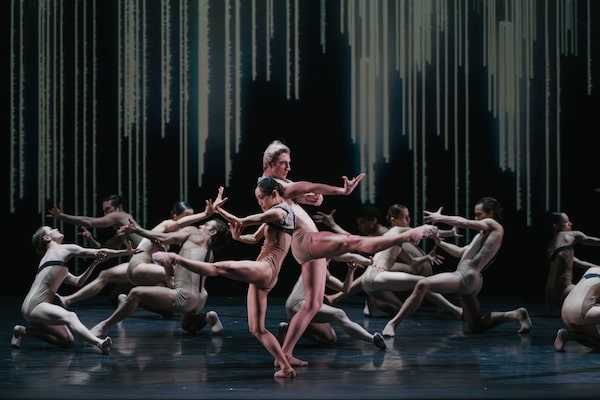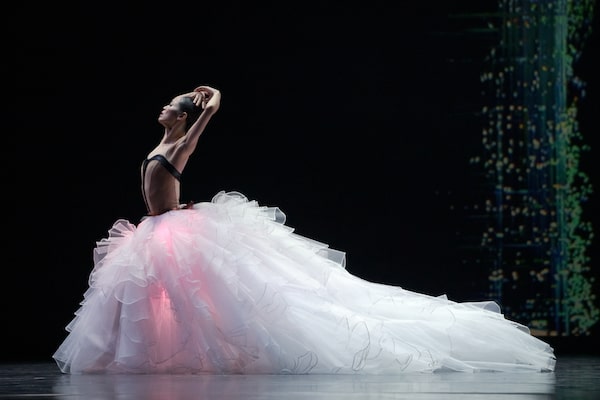
Koto Ishihara and Ben Rudisin perform in William Yong’s multimedia spectacle UtopiVerse.Handout
Title: UtopiVerse, islands, Suite en Blanc
Choreographer: William Yong, Emma Portner, Serge Lifar
Dancers: Ben Rudisin, Koto Ishihara, Heather Ogden, Emma Ouellet, Larkin Miller, Harrison James, Svetlana Lunkina
Company: National Ballet of Canada
Venue: Four Seasons Centre for the Performing Arts
City: Toronto
Year: Runs until March 24
The National Ballet of Canada’s annual Winter Triple Bill delivered tough-to-love works never before seen in Canada, including the world premiere of Toronto-based choreographer William Yong’s multimedia spectacle UtopiVerse.
Yong leads a tech-forward Ontario dance company called Zata Omm, and his commission for the National Ballet makes him the first choreographer of Asian descent to create a mainstage work for the company, an accolade that’s long overdue. Given the National Ballet’s resources, Yong reached for the moon and landed on a nightmarish distant planet populated with bizarre costumes, creepy projected videos and dancers running around with glowing Rubik’s cubes.
The choreographer says he took inspiration from astrophysics and John Milton’s Paradise Lost, but if this hellscape is the Garden of Eden, surely Adam and Eve were glad to get out.
Overloaded contemporary dance works best when the movement vocabulary makes no attempt to compete with elaborate visual elements. Yong’s intentionally awkward choreography only piles on the what-on-earth-is-going-on-here weirdness.
The barefoot dancers do a fabulous job tackling counterintuitive gestures. They caress their own cheeks, for example, by bending their elbows and wrists at opposing right angles. Movement for the corps includes storm trooper-like marching, and an ensemble of dancers prancing around in thick-maned headdresses.
Another sequence late in the 40-minute piece finds a masked female soloist preening while a chilling projection displays a woman wearing a metal muzzle. Only in the central pas de deux, where Ben Rudisin and Koto Ishihara execute complex lifts, did the visual elements, stoic movement and anachronistic music – selections by English composer Benjamin Britten – achieve some sort of equilibrium.

Koto Ishihara in UtopiVerse. Photo by Karolina Kuras. Courtesy of The National Ballet of Canada.Handout
Ottawa native Emma Portner has a better sense of how to draw in curious viewers, not alienate them. islands, her belated North American ballet debut, is a duet for two dancers sharing one pair of pants. Figuring out where the seams are stitched together and whose legs belong where is half the fun of this simple but clever metaphor for navigating relationships.
In recent years, Portner has become the unexpected darling of Nordic dance. Last month in Stockholm she debuted a ballet with each dancer luxuriating in a private bathtub. Some critics loved it, others deemed it too sweet and thin.
I’m not convinced Portner’s honed-on-music-video talent fully translates onstage. The intimacy of islands, a 2020 commission from the Norwegian National Ballet, is difficult to appreciate in a cavernous hall like the Four Seasons Centre. Heather Ogden and Emma Ouellet played the couple tangled up in trousers on Wednesday’s opening night, pale distant figures on a dark stage. These two women would bend over backward for each other, and do, swapping body parts so that one woman’s legs appear connected to the other’s torso. At one achingly tender moment once the pants come off, one dancer rests on her back with her head cradled in the other’s lap.
If only the third ballet chosen had built on Portner and Yong’s creative explorations. Instead, the company dusted off a showy 1943 tutu ballet by Serge Lifar, a Ukrainian-born Ballets Russes dancer who took over the Paris Opera Ballet in 1931. (The National Ballet posted a “historical perspective” on its website this week noting that Lifar continued producing works under Nazi occupation.) His ballets are somewhat derivative of George Balanchine, which makes sense given that Lifar originated the role of Apollo.
Last March, Balanchine’s Symphony in C shared a program with two new works at the National Ballet. In June, the company will perform his iconic triptych Jewels. Maybe some people won’t buy tickets for a triple bill unless tutus are involved. If so, the winter program would have been a welcome chance to revive Jorma Elo’s 2010 commission Pur ti Miro. Or skip the tutus and import Alexei Ratmansky’s Namouna, which is set to the same suite of music by Édouard Lalo as Suite en Blanc.
Lifar may not have been a choreographic genius, but he knew how to put on a show. The second-act curtain reveals a gorgeous tableau of angelic white tulle. Suite en Blanc’s formula is simple even if the steps are not: Each of the eight movements features a different combination of dancers demonstrating various tricks of the ballet trade. Regrettably, those tricks were not all well executed. One trio of women had timing issues, not all the men’s foot-fluttering beat jumps were clean and two women prematurely stumbled sideways out of their fouettés. On the plus side, Larkin Miller made a stunning entrance with his arabesque jumps, and Harrison James and Svetlana Lunkina paired up for a pristine adagio.
Suite en Blanc’s finale, bringing back the soloists to reprise the highlights, is far better than the sum of its parts. The curtain closes on another stunning mise-en-scène, as if Lifar wanted to show all is well with the world and at the ballet, even when the audience knows that’s not so.